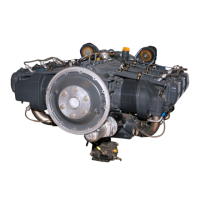TEXTRON LYCOMING OPERATOR'S MANUAL
SECTION 3
0-540 & 10-540
SERIES
USING
CURVE TO FIND ACTUAL
HORSEPOWER
The
following is an example of how
to use the Sea Level and
Altitude
Performance curves for normally aspirated engines, printed on these pages,
to determine actual horsepower
being delivered by the engine
for given
altitude,
RPM, manifold pressure and oil
inlet temperature. This example
(figure 3-8) is for illustration purposes only.
1. Determine
equivalent
full throttle
horsepower
on altitude
performance curve for observed manifold pressure and RPM. Example:
At 2100
RPM and 23.2 inches manifold
pressure, locate Point "A".
2.
Repeat above procedure on sea
level performance curve. Example:
Point "B".
3.
Transfer value
obtained in
step 2 to altitude
performance
curve.
Example:
Point "C".
4.
Connect point "A" and
point "C" with a straight
line.
5. Read horsepower on
line "CA" for given altitude
(Example: At 1500
feet
with a power setting of 2100
RPM and 23.2 in. Hg., horsepower
is
157. Point "D".)
6. Correct
power approximately
1% for each 10
°
variation in intake
air
temperatures from
the standard altitude temperature
shown below.
Add correction
for temperatures below
standard, subtract correction
for temperatures above
standard. (Example:
With an air inlet
temperature of
14°F. at an altitude of 1500
feet, 54°F. - 14°F. = 40
°
variation, 1% for each 10
°
variation is 4%. 4% of 157
horsepower is
approximately
6
horsepower. Since
temperature
is below standard,
add
correction:
157 + 6 = 163 horsepower
- Point "E".)
STANDARD ALTITUDE
TEMPERATURES
IN DEGREES F.
Pressure Altitude
(Thousands) SL
2 3 6 8 1012 14 16
18 20 22 24
Standard Altitude
Temperature
(°F.) 59 52 45
38 31 23 16 9 + 2 -5 -12
-19 -27
3-24

